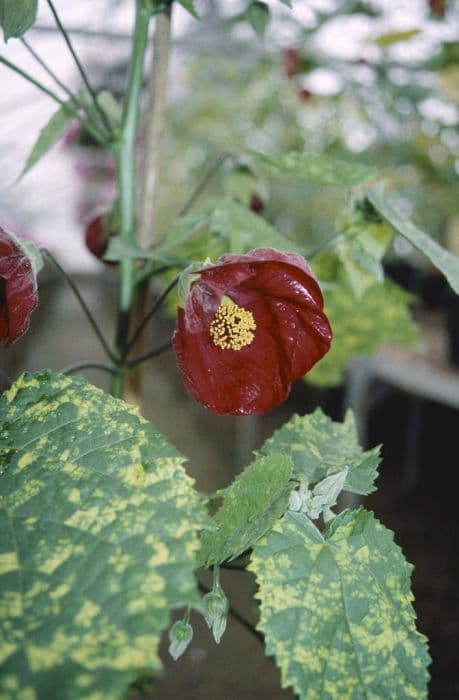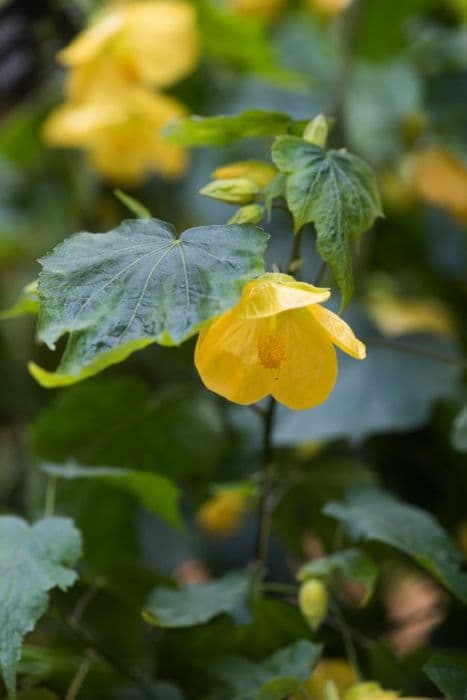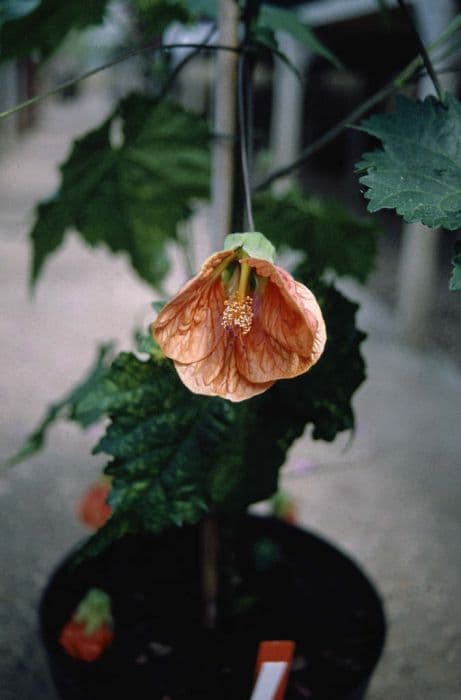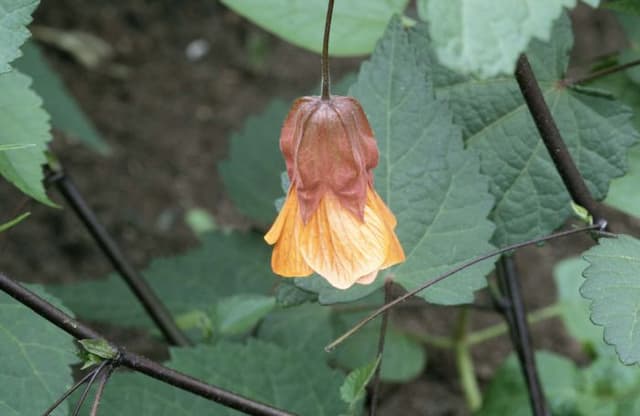Velvet Tree Mallow Corynabutilon × suntense 'Jermyns'

ABOUT
The Corynabutilon × suntense 'Jermyns', more commonly known as the Velvetleaf, is a striking plant that displays a rich, velvety foliage. The leaves are broad and heart-shaped, often with a slightly serrated edge, exuding a lush, green appearance. Its stems are sturdy, supporting the weight of the leaves and flowers. The Velvetleaf is most admired for its blooms, which are large, bell-shaped flowers that hang delicately from the branches. These flowers exhibit a range of colors from pale to vivid mauve, often with a darker center or venation that adds depth and contrasts beautifully with the greenery. The Velvetleaf possesses a singular beauty that is favored in ornamental gardening, bringing an air of elegance and a touch of the exotic to the landscape.
About this plant
 Names
NamesFamily
Malvaceae.
Synonyms
Velvetleaf Abutilon, Jermyn's Abutilon, Suntense Abutilon.
Common names
Abutilon × suntense, Abutilon suntense.
 Toxicity
ToxicityTo humans
The plant commonly known as Velvetleaf is not widely recognized for having significant toxicity to humans. If Velvetleaf is considered toxic and ingested, symptoms could potentially include gastrointestinal discomfort or irritation. However, in the absence of specific toxicity information, it is always wise to avoid ingesting parts of plants not known to be safe and to consult a medical professional if ingestion occurs.
To pets
The plant commonly known as Velvetleaf is not widely recognized for having significant toxicity to pets. If Velvetleaf is considered toxic and a pet ingests it, symptoms could potentially include gastrointestinal upset such as vomiting or diarrhea. As with any plant, if you suspect your pet has ingested Velvetleaf and is showing adverse symptoms, it is recommended to contact a veterinarian.
 Characteristics
CharacteristicsLife cycle
Perennials
Foliage type
Deciduous
Color of leaves
Green
Flower color
Lavender
Height
10 feet (3 meters)
Spread
6 feet (1.8 meters)
Plant type
Shrub
Hardiness zones
8
Native area
Hybrid
Benefits
 General Benefits
General Benefits- Ornamental Appeal: Corynabutilon × suntense 'Jermyns', commonly known as Chilean Bellflower, features attractive purple flowers that enhance garden aesthetics.
- Habitat for Wildlife: It provides nectar for pollinators like bees and hummingbirds, offering ecological support for local wildlife.
- Drought Tolerance: Once established, the Chilean Bellflower can tolerate periods of drought, making it suitable for xeriscaping and low-water gardens.
- Cold Resistance: This plant exhibits a degree of frost resistance, making it a resilient choice in cooler climates where other plants might succumb to cold weather.
- Low Maintenance: It generally requires minimal care, making it a good choice for gardeners seeking low-maintenance plantings.
 Medical Properties
Medical PropertiesThis plant is not used for medical purposes.
 Air-purifying Qualities
Air-purifying QualitiesThis plant is not specifically known for air purifying qualities.
 Other Uses
Other Uses- Textile dye: The flowers of the Varsity Satin Flower could potentially be used to create natural dyes due to their color.
- Garden sculpture support: It can be used as a living support structure for climbing vines or other plants in the garden.
- Educational resource: The Varsity Satin Flower can be used in educational settings to teach about hybrid plant development and botany.
- Artistic inspiration: Artists may use the plant as a subject in painting, photography, or other visual arts due to its distinctive appearance.
- Privacy screening: Due to its size and dense foliage, it can provide privacy in a garden setting when planted in a row or as a hedge.
- Cultural ceremonies: The plant could be incorporated into cultural and religious ceremonies as a decoration or symbol.
- Floral arrangements: The long-lasting flowers can be used in fresh or dried floral arrangements for events and home decor.
- Theme gardens: Varsity Satin Flower can be featured in a purple-themed garden due to its violet and lilac flowers.
- Bee garden contribution: It can be planted as part of a bee-friendly garden to help support local bee populations.
- Photography prop: The distinctive blooms can serve as an interesting backdrop or subject for photographers, particularly those specializing in plant and nature photography.
Interesting Facts
 Feng Shui
Feng ShuiThe Chilean Bellflower is not used in Feng Shui practice.
 Zodiac Sign Compitability
Zodiac Sign CompitabilityThe Chilean Bellflower is not used in astrology practice.
 Plant Symbolism
Plant Symbolism- Resilience: Corynabutilon × suntense 'Jermyns', commonly known as Velvet Musk-mallow, is a hybrid plant that inherits attributes from its parent species, symbolizing the ability to adapt and thrive in various conditions.
- Rarity: As a specific cultivar, Velvet Musk-mallow represents uniqueness and the value of rare qualities in both plants and people.
- Beauty: With its attractive flowers, Velvet Musk-mallow symbolizes natural beauty and the appreciation of aesthetic qualities.
- Growth: The plant's growth habit can symbolize personal growth and development, resonating with the idea of achieving one's full potential over time.
 Water
WaterThe Velvetleaf plant, commonly known as Corynabutilon × suntense 'Jermyns', should be watered deeply once every week during the growing season, and less frequently during winter. It's essential to allow the top layer of soil to dry out slightly before watering again. Water the plant with about 1 to 2 gallons, ensuring that the water reaches the root zone without causing waterlogging. During hot, dry periods, you may need to water more frequently to maintain consistent soil moisture. But when it's cooler, you might cut back to watering every other week, always checking the soil's moisture level before doing so.
 Light
LightVelvetleaf prefers a spot where it receives full sun to partial shade, with protection from the hot afternoon sun in warmer climates. Ideal lighting conditions for Corynabutilon × suntense 'Jermyns' include a bright position with several hours of direct sunlight in the morning, followed by dappled shade in the afternoon. Avoid deep shade, as this can lead to poor flowering and leggy growth.
 Temperature
TemperatureVelvetleaf thrives in temperatures ranging between 50°F and 85°F. Corynabutilon × suntense 'Jermyns' can survive brief periods of colder weather down to about 40°F, but it is not frost-hardy and should be protected or moved indoors if temperatures dip below this point. The ideal temperature conditions for this plant would maintain a steady range without extreme fluctuations.
 Pruning
PruningPruning the Velvetleaf, Corynabutilon × suntense 'Jermyns', is vital for maintaining its shape and encouraging bushier growth. Prune in late winter or early spring before new growth begins. Remove any dead or damaged branches and lightly shape the plant as needed. Pruning can be done annually, or more often if the plant becomes too large or unkempt.
 Cleaning
CleaningAs needed
 Soil
SoilThe Violet Tree mallow prefers a well-draining soil mix with plenty of organic matter. A blend of equal parts loam, peat, and sharp sand with some added compost is ideal. Adjust soil pH to be slightly acidic to neutral, ideally between 6.0 and 7.5.
 Repotting
RepottingViolet Tree mallow should be repotted every 2-3 years to refresh the soil and accommodate root growth. It's best to repot in the springtime when the plant is coming out of dormancy.
 Humidity & Misting
Humidity & MistingViolet Tree mallow thrives in moderate humidity levels. It does not require high humidity, and average room humidity is typically sufficient for this plant.
 Suitable locations
Suitable locationsIndoor
Place in bright, indirect light, avoid overwatering.
Outdoor
Plant in partial shade, sheltered from strong winds.
Hardiness zone
8-10 USDA
 Life cycle
Life cycleCorynabutilon × suntense 'Jermyns', commonly known as Velvet Tree Mallow, begins its life cycle when seeds are sown in spring or when cuttings are taken. These germinate or root, leading to the formation of a young plant which will develop a strong root system over several weeks. As it matures, the plant produces distinctive, heart-shaped leaves and a woody stem, typically reaching maturity in its second or third year. Velvet Tree Mallow is a perennial, and it enters a blooming phase in late spring or early summer, showcasing striking lavender-pink flowers that attract pollinators. After the flowering period, seed pods may form, and once seeds are mature, they can be dispersed to produce new plants. During winter or in unfavorable conditions, the plant may die back, but it will usually re-sprout from the base as temperatures rise in the following spring.
 Propogation
PropogationPropogation time
Spring-Early Summer
Propogation: The most common method of propagating the Chilean Bellflower, or Corynabutilon × suntense 'Jermyns', is through semi-ripe stem cuttings. The best time to do this is in late summer when the stems are mature enough yet still flexible. Cut a 4 to 6-inch (10 to 15 cm) length of stem, remove the lower leaves, and dip the cut end in rooting hormone. Plant the cutting in a mixture of half peat and half perlite or in a well-draining potting mix, then place it in a warm, shaded area, ensuring to keep the soil moist. Within a few weeks, the cutting should have rooted sufficiently to be transplanted.





![Abutilon [Yellow Trumpet]](/_next/image?url=https%3A%2F%2Fplants-admin.emdemapps.com%2Fimages%2Fplants%2F%2Fimages%2F604b5caa8b4fb.png&w=640&q=75)


